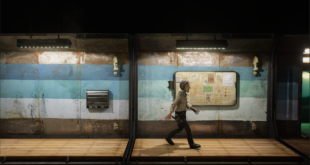A room. A table. A box. The setup of each of Fireproof Games’ instalments in The Room franchise is deceptively simple. Yet, as players begin to explore the mechanical workings of each mysterious object, new puzzles and locations are revealed, taking players on a winding journey in search of the mysterious fifth element, ‘Null’.
It’s a polished premise that has led to major success for Fireproof, the studio founded by former Criterion Games developers. Among a slew of awards, The Room and its two sequels have been downloaded more than 10 million times across mobile and PC.
Although each Room game begins with a similar situation, the three titles introduce original mechanics and ways to interact with their iconic clockwork puzzle boxes, from revealing hidden text with a mystical eyeglass to diving inside the tightly-clasped machinery.
“Really the differences are in scale, as each game is bigger and more complex than the last, and scope, as we try to make successive titles more sophisticated in their mechanics, gameplay and visuals,” explains Fireproof’s commercial director Barry Meade. “That’s just a way of saying we want each game to beat the last in ambition and how much players enjoy it.
“In terms of what we’ve learned from the first two games… well, you can’t argue with knowing what works. The fact that the previous games were a success taught us that our assumptions about what makes an interesting game were not wide of the mark. That gives us great confidence to continue doing what we enjoy doing.”
"Mobile has a long way to go before its potential is exhausted."
Barry Meade, Fireproof
Fireproof used Unity to build all three of The Room titles, a decision that Meade calls “a no-brainer” given the studio’s humble beginnings.
“The Room was only made possible by a confluence of two or three factors,” he explains. “One of which was that Unity arrived on the dev scene, another being that mobile became a viable gaming platform.
"Fireproof only had one programmer when we made The Room and the only reason we could afford Rob Dodd, our lead coder, was because we didn’t have huge bills to pay to an engine maker or platform holder. Without these catalysts The Room would never have happened.”
With limited spatial environments, The Room Three and its ilk dedicate much of their performance resources to highly detailed textures and complex audio soundscapes – a focal point often eschewed by developers working with the relatively limited power of mobile devices.
“All three Room games run on the iPhone 4S and we are sometimes asked how we got that fidelity of artwork on such old devices,” Meade reveals. “We used to design and build open-world racing games on console so, to be honest, working to a budget and maintaining framerate was far easier on The Room than it was when we made the Burnout games. As an art team we’ve been ploddingly churning out cities full of low-poly inanimate objects for most of our careers so it’s no coincidence The Room is all about sexy looking objects that don’t move.
“There’s no trick to it – our meshes aren’t more complex than any other devs – we’ve just been schooled over the years in how to make good art decisions to mask how cheap our assets are.”
When it comes to constructing The Room’s intricate puzzles, Meade says that testing is vital to ensure that everything runs like clockwork.
“Creative director Mark Hamilton and Fireproof co-founder Chris Cannon start with a bunch of ideas for boxes or puzzles and then, together with our designers Jeremy and Tom, whittle the ideas down to the ones that seem the most interesting mechanically or visually,” he recalls.
“From there they are refined through use – we build them immediately, begin to play and if they work, they stay and undergo iteration. For the games’ difficulty level we just try to maintain a somewhat gentle journey for the player. We don’t believe in making a game overly difficult; we want people to get to the end and get their money’s worth.”
The Room’s puzzles can stump players with their enigmatic solutions, but there’s one element of the game that isn’t confusing: its controls. Every action, from manipulating object puzzles to traversing the environment, is executed with simple touch inputs.
“In 2012, we had a number of ideas for mobile games, but we chose the ‘Puzzle Box’ idea – which became The Room – because, above all else, we wanted to make a game that used the touch interface really well,” Meade recollects.
“The coding side of that was not easy, however; Rob spent a lot of time redoing stuff to get the gestures and physics working as well as we could in the time we had. The touch interface is an interactive language that every mobile user speaks and is a gift to developers. Used sensibly, it’s a gateway to understanding – not confusion.”
It’s been a whirlwind few years for Fireproof. Since the first Room in 2012, the studio has released a new entry every year (an expansion in 2013, followed by the two direct sequels), as well as bringing the original to PC.
Its debut served as one of the first examples of a console-quality experience utilising mobile’s unique aspects – yet Meade believes that most developers building for iOS and Android still fail to make the most of the platform, meaning plenty of potential for innovative newcomers remains.
“For all its claimed dynamism and data-based planning, it seems to take our industry an eternity to learn anything on this platform,” he laments.
“Mobile remains a platform that delivers a very specific type of game to a specific type of audience. That vacuum suggests mobile has a long way to go before its potential is exhausted. I always advise devs not to listen to the noise – if there’s a gap in the mobile market for what they want to make, go for it.”
As for Fireproof itself? Unsurprisingly, the studio isn’t done with The Room just yet. Although, with the prospects of virtual reality growing, Meade hints that the franchise may be set to revolutionise a completely different medium.
“We want to continue making games in the Room universe, but we’re not ready to jump onto The Room Four just yet,” he reveals. “We’re very interested in VR and what’s possible with a game like ours in that space, so we hope to investigate that a bit more this year. We also love PC and console as a market, and have some ideas for how we may get on those platforms in an interesting way.
"But, for now, it’s all exploration.”
EDIT: This article originally said the Room games have been downloaded five million times – this number has now passed 10 million.

 MCV/DEVELOP News, events, research and jobs from the games industry
MCV/DEVELOP News, events, research and jobs from the games industry



